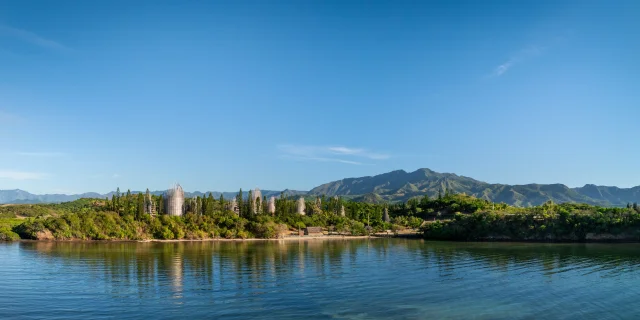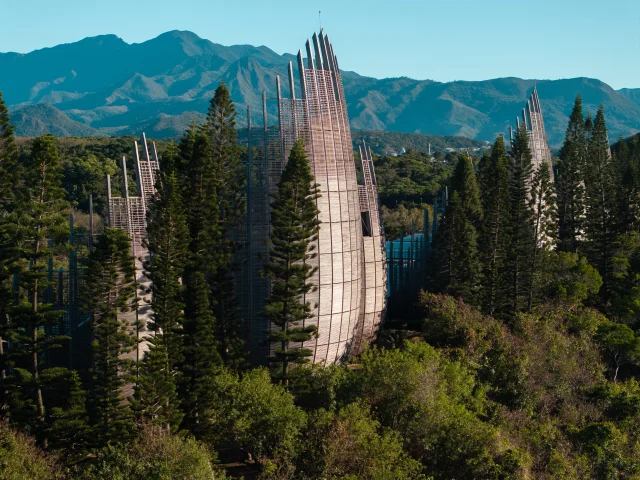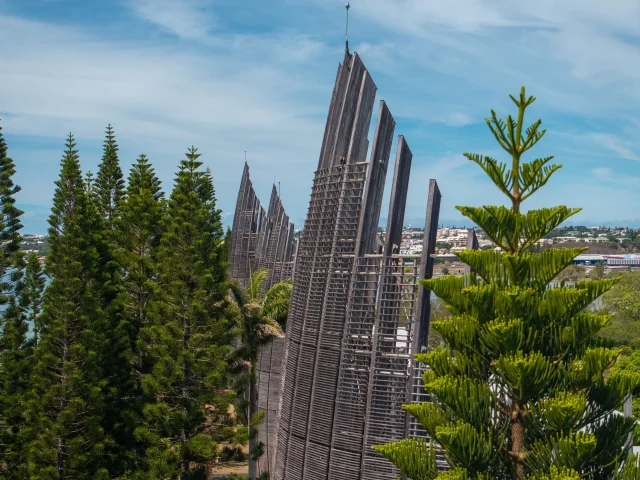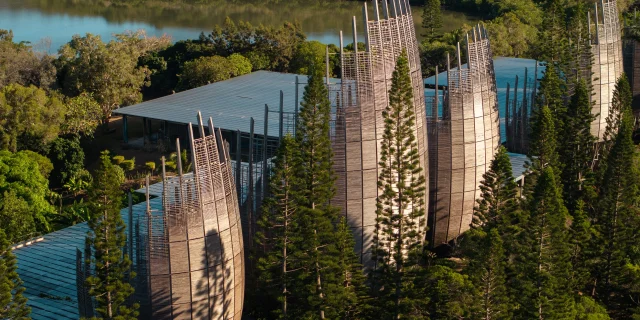Must-see places
A place not to be missed
Listed in the top 10 places to visit in New Caledonia
 CENTRE-CULTUREL-TJIBAOU_CHARLOTTE-BERTONNEAU
CENTRE-CULTUREL-TJIBAOU_CHARLOTTE-BERTONNEAUA place not to be missed
Listed in the top 10 places to visit in New Caledonia
As per the Matignon Accords of 1988, the Centre Culturel Tjibaou was built on the site that hosted the 1975 Melanesia 2000 festival, organised by Jean-Marie Tjibaou, a Kanak independence leader. This event was the first large-scale gathering that celebrated Kanak traditions in New Caledonia. Inaugurated on the 4 May 1998, the cultural centre that we know today bears the name of its charismatic leader, and is directly aligned with the goal of showcasing the island’s vernacular culture. Today, the Agence de Développement de la Culture Kanak (ADCK) manages this public institution. Its goal? To promote Kanak cultural heritage, especially artistic creation; to encourage the emergence of cultural references common to the different customary areas; and to ensure that Kanak culture thrives throughout the Oceania region.
“Enjoy Tjibaou Cultural Center in a sunny day ! The mangrove and the seaside make the stroll even better !”
Nellye, Office de Tourisme de Nouméa
Have you heard of the renowned architect Renzo Piano? He’s the one who imagined and designed the Tjibaou Cultural Centre! He’s best known for his design of the Centre Georges Pompidou in Paris.
Conceived in collaboration with the Agence pour le development de la culture Kanak (ADCK), the interior and exterior designs reflect people’s attachment to nature. Built on a beautiful 8-hectare site, the complex is modern and monumental. Like a hymn to Kanak culture, it features ten slender units called “cases,” or hut pavilions, combining modern design with traditional forms. Made of steel and Iroko wood, they range in height from 20 to 28 meters, and feature a clever natural ventilation system. A path lined with columnar pines links the huts together, forming three distinct villages, each dedicated to a particular function. The total surface area of the various buildings is 7,000 square metres. You can stroll from hut to hut, sometimes outdoors, sometimes indoors, exploring the different spaces offered by the cultural centre.
 default
default default
defaultThe buildings blend harmoniously into their surroundings. The large park surrounding the museum is made up of different areas symbolising essential elements of Melanesian culture. Near the museum, don’t miss the “Kanak path”. It recounts the myth of the first man Téâ Kanaké, symbolised by endemic plants and their language.
Five stages are represented along the initiatory journey:
Three traditional huts, a faré, and several dance and performance spaces blend into the natural surroundings. While wandering in the park, have fun identifying yam, houp, or kaori, which are plant species of huge importance in Kanak tradition. Finally, to appreciate the poetic beauty of the place, you can visit the belvedere overlooking Magenta Bay, or the statue of Jean-Marie Tjibaou at the top of the hill.
 default
defaultWith a museum, a performance space, and a media library, the Centre Culturel Tjibaou is a meeting place for cultural creation. There are plenty of reasons to visit! For your first visit, take the time to explore the museum’s huts that are dedicated to permanent exhibitions. Among them, the Bwenadoo hut showcases Kanak heritage objects borrowed from international museums, such as the Quai Branly in Paris. The large Jinu hut offers a glimpse of Pacific civilisations through sculptures from Papua New Guinea, the Solomon Islands, Vanuatu, New Zealand, and New Caledonia. Finally, the Mâlep hut recounts the story of Jean-Marie Tjibaou.
In addition to its permanent spaces, the centre also hosts local artistic productions and international events. Four venues, including three outdoors, host a wide range of music, theatre, and dance performances. Among the highlights of the year, the Francofolies de Nouvelle-Calédonie festival and the Waan Danse Festival are must-see events! The programme also includes plays, lectures, and open-air film screenings. The symbolism of the site and the beauty of its setting add a touch of magic to these events.
You won’t be disappointed with the temporary exhibitions either! The Fonds d’Art Contemporain Kanak et Océanien (FACKO) showcases quality works of art throughout the year. Artists in residence at the Centre Culturel Tjibaou also contribute to the cultural dynamic of the site, and regularly show their work. In the Bérétara and Kavitara rooms, you can admire the creations of regional artists.
To make sure you don’t miss out on any of the cultural programming at the Centre Tjibaou, check out our diary of events in the South Province!
The iconic Francopholies festival is one of the biggest in New Caledonia, bringing together international artists every year to the delight of the locals.
Francofolies festival is on the most important in New Caledonia. International and famous artist hit the stage for french music lovers !
Fancy a guided tour or a special activity? All year long, you can take part in tours or special days. On the first Saturday of the month, the centre organises a wonderful family discovery day (reservation required). Called Beu Ya, this experience lets you share in the gestures and knowledge of Kanak men and women: welcoming customs, food preparation, the language of plants, and so much more. After a lunch to savour the bougna, you’ll be invited to take part in a workshop, listen to a story, or discover a traditional game. It’s a perfect visit with kids!
Beu Ya : listen to the words of the elders in Kwenyii, the language spoken on the Ile des Pins.
Among the other flagship activities at the Centre Culturel Tjibaou, the “animated Kanak trail” reveals the secrets of the myth of the first man every Tuesday afternoon (reservation required). To the sound of percussion and dance, this wandering show by the We Ce Ca company guides and instructs you on a journey through plants. A market of women farmers takes place at Tjibaou every month to support small producers. An opportunity to discover local products! Storytelling, music, and educational workshops are also available for kids. . Check out our practical information sheet to learn more!
 Centre Culturel Tjibaou Nouméa - Scultures
Centre Culturel Tjibaou Nouméa - SculturesTips you need to know
Getting there
Distance from downtown Nouméa: 8 kms (15 min)